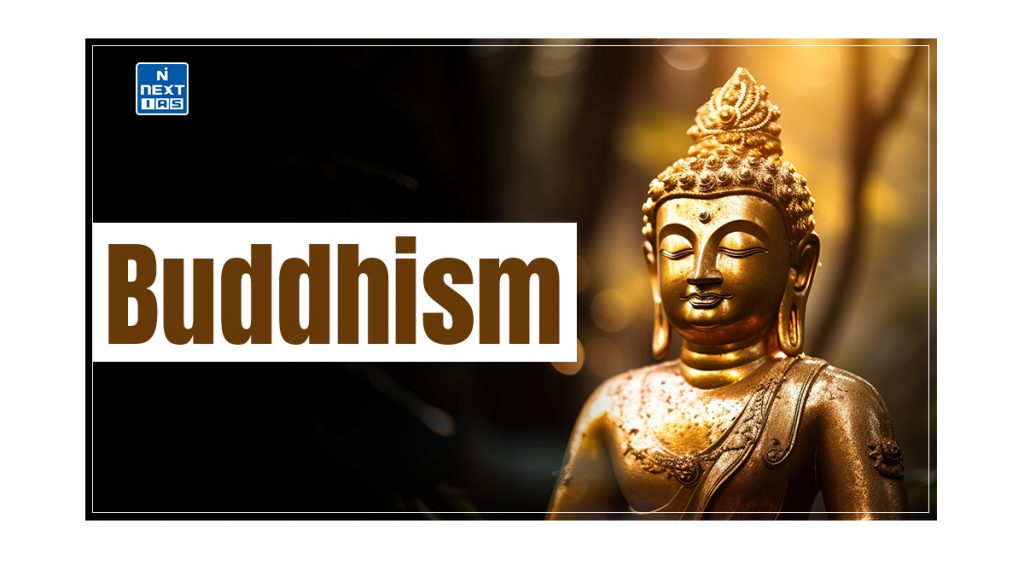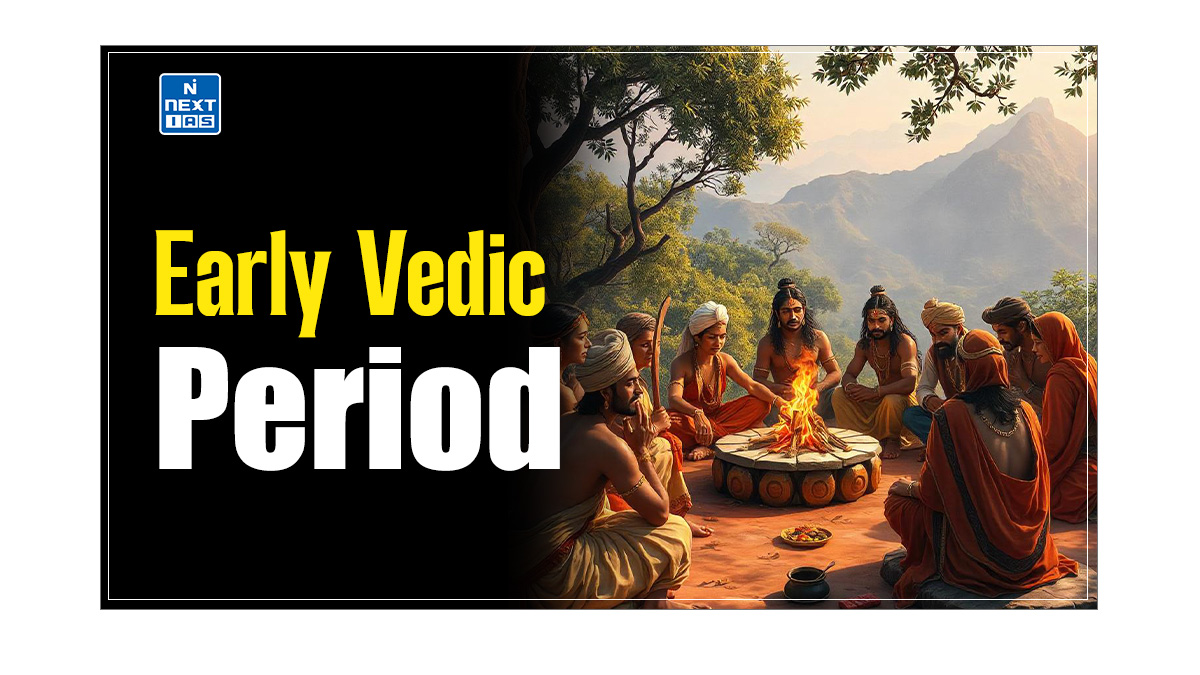
Buddhism in India is a profound spiritual tradition founded by Gautama Buddha, focusing on the path to enlightenment through ethical living, meditation, and wisdom. Its significance lies in shaping Indian culture and philosophy, promoting peace, non-attachment, and compassion. This article aims to study in detail Buddhism, its origin & spread, doctrines & teachings, and impact of Buddhism throughout history.
About Buddhism
- Buddhism, one of the world’s major religions, was founded in India in the 6th century BCE by Siddhartha Gautama, who is popularly known as the Buddha.
- Rooted in the teachings of the Buddha, it centres on the path to enlightenment through understanding the Four Noble Truths and following the Eightfold Path, which guides ethical conduct, mental discipline, and wisdom.
- Its fundamental tenet is the belief in the impermanence of all things and the cessation of suffering through the renunciation of desire and attachment.
- Its focus on compassion, meditation, and the pursuit of wisdom has profoundly shaped Asia’s spiritual and cultural landscape.
- Its teachings inspire millions worldwide, offering a path to inner peace and liberation from the cycle of birth and rebirth.

Who is Gautama Buddha?
- He was born in 563 BCE, Lumbini (Nepal), Shakya Republic.
- His parents were Suddhodana (father) and Maya Devi (mother).
- According to tradition, he was born in 563 B.C. in a Shakya Kshatriya family in Lumbini, Nepal, near Kapilavastu.
- His birthplace is identified with Piprahwa in Basti district, close to the foothills of Nepal.
- Gautama’s father was believed to have been the elected ruler of Kapilavastu, who headed the republican clan of the Shakyas.
- His mother was a princess from the Koshalan dynasty.
- Thus, similar to Mahavira, Gautama also belonged to a noble family.
- He was moved by the misery people suffered and looked for a solution.
- Like Mahavira, he left home at the age of 29. He wandered for about seven years and attained knowledge at the age of 35 at Bodh Gaya under a Peepal tree.
- Here onwards, he began to be called the Buddha or the enlightened.
- He died in 483 BCE in Kusinagar (Uttar Pradesh), Malla Republic.

Five Events in Buddha’s Life
| Events | Symbol |
| 1. Janma (Birth) | Elephant |
| 2. Mahabhinishkramana (Renunciation) | Horse |
| 3. Nirvana/Sambodhi (Enlightenment) | Bodhi tree |
| 4. Dharmachakra pravartana (1st sermon) | Wheel |
| 5. Mahaparinirvana (Death) | Stupa |
Teachings of Buddhism
After attaining nirvana, Lord Buddha started teaching people the way of life. He shared his first teachings near Benaras (Banaras) with five holy men. His teachings are also known as Dhamma. There were three teachings of Buddha, which are given below:
- Nothing is lost in the Universe: Matters turn into energy, and energy turns into matter. Old solar systems disintegrate into cosmic rays.
- It was said that we are the children of our parents and will be our children’s parents.
- By destroying something around us, we are essentially harming ourselves. By lying to others, we deceive ourselves. Recognizing these truths, Lord Buddha and his followers abstained from killing animals.
- Everything Changes: Everything is continuously changing. Nothing is permanent.
- Dinosaurs and mammoths once dominated this planet, but now we humans rule it.
- Life is like a river; it keeps on flowing, ever-changing.
- Law of Cause and Effect: Nothing ever happens to us unless we deserve it.
- This law is known as Karma, and is mentioned in Dhammapada too.
- According to it, if we do good things, then good things will come to us. But, if we do something evil, then evil things will happen to us.
| “The kind of seed sown will produce that kind of fruit. Those who do good will reap good results. Those who do evil will reap evil results. You will joyfully gather good fruit if you carefully plant a good seed.”—Dhammapada |
Doctrines of Buddhism
The four great doctrines of Buddhism are:
- Life is full of sorrow (Dukha).
- There are causes of sorrow (Dukha samudaya).
- This sorrow can be stopped (Dukha Nirodha).
- There is a path leading to the cessation of sorrow, which has been called as Dukha Nirodha Gamini Pratipada.
Eight-Fold Path of Buddhism
Ashtangika marga or eight-fold path (for the elimination of human misery).
- Right View: The right knowledge of the cause of suffering, knowledge to end the cause of suffering, and the path to end the suffering.
- Right Intention: Right Intent must come from the heart.
- It involves recognising the equality of all life and compassion for all, beginning with yourself.
- Right Speech: Right speech involves recognising the truth and awareness of the impact of idle gossip and repeating rumours.
- Right Action: Right Action also encompasses the five precepts that the Buddha gave: not to kill, steal, lie, avoid sexual misconduct, and not to take drugs or other intoxicants.
- Right Livelihood: Right Livelihood also implies that a Buddhist who can undertake some work, either as part of a Buddhist community or in the workplace or do home-based or community service.
- Right Effort: Also called as “right endeavour”, it entails that one should always try to take any action on the goodwill of people.
- Right Mindfulness: One should constantly be aware of phenomena affecting the body and mind. This means one must be aware of one’s thoughts, words, and actions.
- Right Meditation: Also known as “right meditation”, Right concentration teaches people to focus and concentrate on one thing or object at a time.
Social Orders and Legislation of Buddhism
- The Buddhist social hierarchy centres on the ‘Sanghas’ or ‘order of disciplines’.
- The Sanghas are the groups of Monks who convey the instructions of Buddha across the world.
- Monks are usually based in monasteries, teaching students to spread their teachings worldwide.

- The Buddhist Monasteries are home to those who devote their life entirely to the Buddhist religion.
- The Buddhist monks are the highest group in its social hierarchy. They are the most respected and valued members of the community.
- The next class in the Buddhist social hierarchy is the nuns, usually the monks’ assistants.
- A symbolic idyllic relationship exists between the common Buddhist people and their monks. The lay people provide the monks with everything necessary for their daily lives, including food, shelter, and medicines.
- The Buddhist pilgrims form the lower end of their social hierarchy. These people are Buddhist believers from multiple places who travel from one location to another in search of knowledge.
- The legislation of Buddhism was based on Karma. Karma means action, which means “to do”.
- The Law of Karma teaches that similar actions produce similar results.
- For example, if we plant a mango seed, the plant that springs up will be a mango tree, and eventually, it will bear mango fruit.
- Similarly, if we do a wholesome action, eventually, we will get wholesome fruit. If we perform an unwholesome action, eventually, we will get an unwholesome and painful result.
Special Features of Buddhism
- It does not acknowledge the existence of god and soul (atman).
- This was a revolution in the history of Indian religions,
- Buddha kept things simple and did not indulge in complex philosophical discussions, which won the support of the common people.
- It attacked the Varna system and hence won the faith of the lower caste.
- It made a special appeal to the people of non-Vedic areas, where it found virgin soil for conversion.
- For example, Magadha was placed outside Aryavata and considered inferior by Brahmans. Hence, the people of Magadha responded readily to this religion.
- Buddha’s tried to fight evil with goodness and hatred with Love.
- He refused to be provoked by abuse and slander by maintaining poise and calm composure and answering with the presence of mind.
Core Principles of Buddhism
Some of its core principles of are as follows:
- Nirvana: The ultimate aim of life is to attain nirvana, the eternal state of peace and bliss, which means liberation from the cycle of birth and death. It is also known as moksha or salvation.
- Karma: It refers to the spiritual principle of cause and effect, where the intent and actions of an individual (cause) influence the future of that individual (effect).
- It is the concept of reincarnation or the cycle of rebirths (samsara).
- Ahimsa: Ahimsa is based on the premise that all living beings have the spark of the divine spiritual energy. Thus, hurting another being is akin to hurting oneself. Buddha laid down a code of conduct for his followers as done by Jaina:
- Do not covet the property of the others.
- Do not commit violence.
- Do not use intoxicants.
- Do not speak a lie.
- Do not indulge in a corrupt practice.
- Sangha: Gautama Buddha also organised the Sangha, or religious order, which was open to everybody, irrespective of caste and sex.
- Women were also admitted to the Sangha.
- The sole requirement for the monks was to diligently adhere to the rules and regulations of the Sangha.
- They organised preaching under the auspices of the Sangha.
- The rules made for the monks in Buddhist Sangha were written down in a book called Vinaya-Pitaka.
- Separate branches existed for men and women.
- All men could join the Sangha. Children had to seek permission from their parents, wives of their husbands, slaves of their masters, debtors of their creditors, and people who worked for the king from the king himself.
- People who joined the sangha led simple lives, meditated most of the time, and begged for food during fixed hours. Hence, they were called Bhikkhus and Bhikkhunis.
- Dhamma: As the Buddha taught, Dhamma is about ourselves and freeing ourselves from personal suffering.
- As suffering beings, we are deluded about the truths of our bodies and minds.
- However, if we practice the Dhamma, we focus on our body and mind and unveil their true characteristics. Our suffering lessens as we gradually understand the Dhamma more and more.
Spread of Buddhism
- Buddha’s teachings spread to many countries, first to Southeast Asia, then through Central Asia to China and the rest of East Asia, finally to Tibet and then to Central Asia.
- Rulers adopted its teachings to help teach their people ethics. The Buddha’s teachings spread peacefully across the Indian subcontinent and eventually reached far and wide throughout Asia.
- Whenever this religion reached a new culture, its methods and styles were freely modified and adapted to fit the local mentality, while preserving its core points of wisdom and compassion.

- King Asoka also actively promoted it beyond his kingdom by sending missions to distant regions, often responding to invitations from foreign rulers, such as King Devanampiya Tissa of Sri Lanka.
- The Theravada tradition spread from India to Burma (Myanmar) and Sri Lanka in the 3rd century BCE.
- From there, it reached to the rest of Southeast Asia (Cambodia, Thailand, and Laos).
- Other Hinayana schools spread to modern-day Pakistan, Afghanistan, eastern and coastal Iran, and Central Asia.
- From Central Asia, they spread into China in the 2nd century BCE.
- The Mahayana eventually became the dominant form of Buddhism in China and most of Central Asia.
- Later, the Chinese form of Mahayana spread to Korea, Japan, and Vietnam.
- These forms of Hinayana were later combined with Mahayana aspects that came through the same route from India.
- The Tibetan Mahayana tradition started in the 7th century CE, inheriting the entire historical development of Indian Buddhism.
- From Tibet, this tradition spread throughout the Himalayan regions to Mongolia, Central Asia, and many areas of Russia (Buryatia, Kalmykia and Tuva).
Main Followers of Buddhism
- Bimbisara and Ajatshatru (Magadha), Prasanjit (Kosala), Udayana (Kaushambi) and Pradoyata (Avanti) were among the followers of Buddha.
- Pradyata invited Buddha to his kingdom.
- King Asoka played an important role in propagating it. Asoka’s son Mahendra and daughter Sanghmitra were sent to Sri Lanka to preach and propagate this religion.
- He also sent agents to Central and West Asia, making it a world religion.
- Emperor Kanishka also patronised it and took measures to propagate it outside India.
- It was also adopted by the merchant class.

Sects of Buddhism
| Hinayana Buddhism | Mahayana Buddhism | Vajrayana Buddhism |
| Its followers believed in the original teaching of Buddha | Its followers believed in the heavenliness of Buddha | Its followers believed that salvation could be best attained by acquiring the magical power, which they called Vajra |
| They developed with the Sangha as the centre | They developed with the individual as the centre | – |
| Their scriptures are written mainly in Pali and are founded on the Tripitaka. | Their scriptures are written in Sanskrit are the sutras | – |
| They centred around the acts of Buddha | They centred around the symbolism of Buddha’s life and personality | – |
| They believe in salvation by works, that each man must work out his own salvation. | They believe in salvation by faith. | – |
| They stressed righteous action and the law of Karma | They held that over and above the law of karma was the law of karuna or compassion | – |
| Their idea is the Arhat, who strives after his redemption | They uphold the ideal of the Bodhisattva or saviour who is concerned with the salvation of others | The chief divinities of this new sect were the Taras. |
| Hinayana literally means the lesser vehicle | They literally mean the greater vehicle | – |
| They did not believe in idol worship. | They believe in idol worship. | – |
| It is known as the ‘Southern Buddhist Religion’ because it prevails in the South of India, i.e., Sri Lanka, Burma (Myanmar), Syam (Thailand), Java, etc. | It is known as the ‘Northern Buddhist Religion’ because it prevailed in the North of India, e.g., China, Korea, Japan, etc. | It became popular in eastern India, particularly Bihar and Bengal. |
Buddhist Councils
| Council | Venue | Chairman | Patron | Result |
| 1st (483 BC) | Saptaparni cave (Rajgriha) | Mahakassapa | Ajatshatru (Haryanka dynasty) | Sutta-Pitaka and Vinaya Pitaka were compiled by Ananda and Upali, respectively |
| 2nd (383 BC) | Chullavanga (Vaishali) | Sabbakami | KalAsoka (Shisunaga dynasty) | (a) The monks of Vaishali wanted some change in rites.(b) Schism into Sthaviravadins and Mahasanghikas |
| 3rd (250 BC) | Asokarama Vihar (Patliputar) | Mogaliputta Tissa | Asoka (Maurya dynasty) | Compilation of AbhidhammaPitakaThe decision to send missionaries to various parts of the world |
| 4th (98 AD) | Kundalavana (Kashmir) | Chairman-Vasumitra Vice Chairman-Ashvaghosa | Kanishka (Kushana dynasty) | (a) Compilation of Mahavibhashashastra (Sanskrit comment on Tripitaka)(b) The division of Buddhists into Hinayanists and Mahayanists |
Importance and Influence of Buddhism
- The Buddhists showed a keen awareness of the problems faced by the people of Northeast India in the 6th century B.C.
- To eradicate evils like poverty, which breeds cruelty and violence, Buddha advised that farmers be provided with grain and other facilities, traders with wealth, and labourers with wages.
- The code of conduct prescribed for the monks reacted against the material conditions of northeast India in the 6th and 5th centuries BC. It restricted the monks’ food, dress, and sexual behaviour.
- It tried to consolidate the changes in the social and economic life of the people.
- The rule that debtors were not permitted to be members of the Sangha naturally helped the rich and moneylenders from whose clutches the debtors could not be saved.
- Similarly, the rule that slaves could not join the Sangha helped the slave owners.
- It made a significant impact on society by keeping its doors open to women and kshudras.
- Since Brahmanism placed women and kshetras in the same category, they were neither given sacred threads nor allowed to read the Vedas.
- Their conversion to Buddhism freed them from such marks of inferiority.
- Buddhism emphasised non-violence and the sanctity of animal life and boosted the country’s cattle wealth.
- Buddhism created and developed a new awareness in intellect and culture. It taught people not to take things for granted but to argue for and judge them on their merits.
- The Buddhists created a new language called Hybrid Sanskrit. Buddhist monks’ activities continued even in the Middle Ages, and they composed some famous Apabhramsha writings in East India.
- The Buddhist monasteries developed as great learning centres and can be called residential universities.
- For example, Nalanda and Vikramashila (Bihar) and Valabhi (Gujarat).
- The first human statues worshipped in India were those of the Buddha.
- Buddhist art flourished in the Krishna Delta in the South and Mathura in the North.
Causes of Decline of Buddhism
- By the early twelfth century A.D., Buddhism had practically become extinct in India.
- It continued to exist in a changed form in Bengal and Bihar until the eleventh century, but after that, it almost completely vanished from the country.
- Initially, Buddhism was inspired by the spirit of reform, but later, it succumbed to rituals and ceremonies it initially denounced.
- Buddhist monks were cut off from the mainstream lives of general populace.
- They gave up Pali, the language of the people, and adopted Sanskrit, the language of intellectuals.
- From the 1st century A.D. onwards, they engaged in widespread idol worship and received numerous offerings from devotees.
- Some monasteries, such as Nalanda, collected revenue from as many as 200 villages. Hence, by the 7th century A.D., the Buddhist monasteries had become dominated by ease-loving people and became centres of corrupt practices that Gautama Buddha strictly prohibited.
- The enormous wealth of the monasteries with women living therein led to further degeneration.
- Buddhists came to look upon women as objects of their lust.
- Attacks of Huna, such as Mihirakula, and the Turkish invaders, such as Bakhityar Khilji, led to the decimation of Buddhism.
- The Huna king, Mihirakula, who was a devotee of Lord Shiva, killed hundreds of Buddhists.
- In early medieval times, the Shaivites and Vaishnavites bitterly opposed the Jainas and Buddhists in South India. Such conflicts may have weakened Buddhism.
Conclusion
In conclusion, Buddhism, with its profound teachings of compassion, non-violence, and the pursuit of wisdom, has left an indelible mark on the spiritual, cultural, and intellectual landscapes of Asia and beyond. Despite its decline in India due to various internal and external factors, Buddhism’s influence continues to thrive globally, offering a path of peace and enlightenment to millions. Its legacy lives on not only through its teachings but also through its contributions to art, education, and societal reforms, reflecting a timeless quest for truth and harmony in human life.
Frequently Asked Questions (FAQs)
Is Buddhism a religion?
Buddhism is often considered a religion, though it differs from many other religions in its focus and practices.
Why did Buddhism decline in India?
The decline of Buddhism in India is attributed to several factors, such as – revival of Hinduism, attacks hu Hunas, decline of monastic institutions, etc.
What is Zen Buddhism?
Zen Buddhism is a school of Mahayana Buddhism that emphasises meditation (Zazen) and direct experience over theoretical knowledge. It originated in China during the Tang dynasty as Chan Buddhism and later spread to Japan, where it became known as Zen.
Who started Buddhism?
Buddhism was founded by Siddhartha Gautama, who is known as the Buddha.






